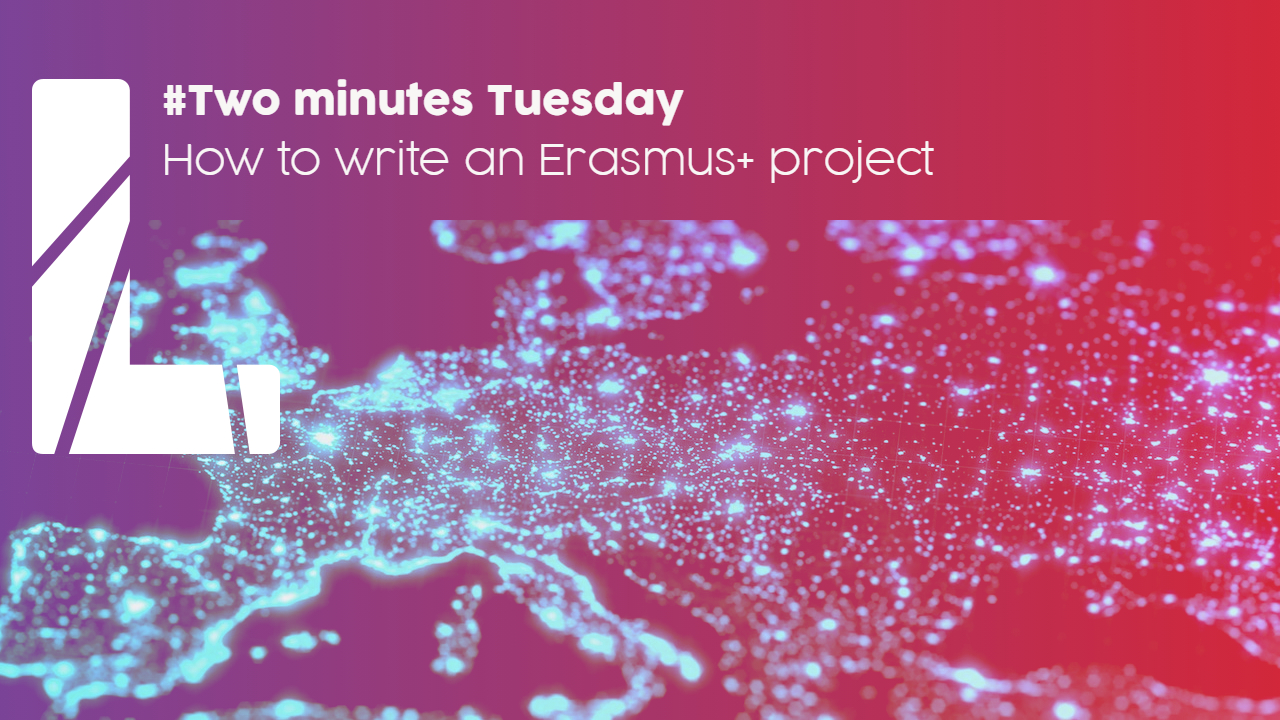Two minute Tuesday #3 - Priorities and topics
Two minute Tuesday #3 - Priorities and topics
The first section of the Erasmus+ application form for a strategic partnership project in the field of education, training and youth, is dedicated to the description of the priorities and topics related to your project.
The European Commission sets the Erasmus+ Programme priorities according to the lines of action defined in the Work Programme. Priorities are defined and described in the section “What are the aims and priorities of the Strategic Partnership” of the Programme Guide and can slightly vary from year to year.
What you need to know
– There are two types of priorities: horizontal (general priorities relevant for all the fields) and specific priorities relevant to the different fields (education, training and youth).
– Every year the European Commission selects one or more priorities considered as highly relevant to the action as it is addressing a particularly important and urgent European issue.
– Among the priorities, National Agencies may give more consideration to those that are particularly relevant in their national context (“European priorities in the national context”)..
– To be funded, Strategic Partnerships must address either a) at least one horizontal priority or b) at least one specific priority relevant to the field of education, training and youth
What you must do
– check the Erasmus+ priorities every year. You can find the priorities in the section “What are the aims and priorities of the Strategic Partnership” of the Programme Guide.
At the moment there is no news about the priorities for the next Erasmus+ Programme 2021-2027. Rumors, confirmed by some national Agencies, are saying that they will be related to three main topics: digital transition, green transition and inclusion.
– Check the most relevant ones for the European Commission and your National Agency.
National Agencies must duly inform potential applicants through their official websites or through Infodays. If it is not your case, we suggest you contact your National Agency asking for information about it.
Field 1: The section starts with the selection of the most relevant horizontal or sectoral priority according to the objectives of your project
Usually this is a drop-down menu through which you must select what is the most relevant priority for you. It can be horizontal or field specific.
.
Field 2: The application form follows asking for up to two additional priorities according to the objectives of your project
Remember: it is much better to include only one priority, that really fits your project idea, than more priorities with no well founded connections. In the first case your proposal will have the requirements for being evaluated, in the second case it will be rejected, or at least the evaluator will start thinking your proposal is not so focused on the problem you want to solve.
Focus on the priority which really fits with your project idea and discard those not perfectly related to your project. A common mistake is trying to add priorities at any cost. This is definitely a bad choice
Field 3: Please comment on your choice of priorities
This is a very important field. You must describe to the evaluator why your project addresses the priorities selected. The evaluator cannot be so expert on the project topic and should have all the information needed for assessing if your project can impact on the selected priorities.
If the project addresses a horizontal priority, it must clearly prove the impact in the field under which the application is presented.
If the proposal addresses one or more “European Priorities in the national context”, as announced by the National Agency, it will be considered as highly relevant to the action as it is addressing a European issue of particular importance in the national context.
If the proposal does not provide convincing evidence that is relevant to at least one priority, the proposal must be scored as “Weak” (score between 0-9 points) for the award criterion “Relevance of the project” as a whole, and rejected as a consequence.
Field 4: Select up to three topics addressed by your project
This is a drop down menu through which you have to select up to 3 topics related to your project. This will help the evaluator in understanding your project idea and the topics addressed.
A good practice is to validate your project idea based on the Erasmus+ Priorities just at the beginning of the idea development process, so to be sure your project addresses the issues selected by the European Commission.
Filling in this section shouldn’t be difficult if you have a clear project idea behind, but you have to provide evidence as clearly as possible in order to help the evaluator and valorise your project.
We are working on the next Erasmus + call. If you want to be our partner or have a proposal to be developed, get in touch.
Two minutes Tuesday #2 - How to create a successful Erasmus+ partnership in 5 steps

Two minutes Tuesday #2 - How to create a successful partnership in 5 steps
You should create a super partnership. Yes “super”, because you will have no chance to be funded with a partnership which is average/just sufficient. There are a lot of extraordinary organisations out there applying for Erasmus+ projects and if you want to be competitive, you have to include the best partners for your project idea.
As you can imagine this is a critical step which can greatly affect the entire project proposal. Or, at least this is our vision. We, as Learnable, during the years had some wrong partners: somebody seemed “disconnected” from the project from long periods, others did not work if not pushed for every single activity, still others did not produce high quality results.
These situations can become very stressful to be managed and can affect both the project results and the partnership relationships.
One wrong partner can ruin the entire partnership’s work. “Why should I work with high quality standards if a partner with my exact responsibilities (and working days/budget) does not?”. That’s the point.
On the contrary, if you have great partners, they will push each other to get the best out of everybody. For a Coordinator this makes a tremendous difference.
Now we give special attention to selecting the project partners. Following specific criteria, we realised that we can create a successful partnership.
Even if it appears easier, we suggest to not include an organisation just because it answered your partner search message on Facebook.
Here are some steps that we are using to maximise the partnerships effectiveness and the chances of having our project approved.
1. Stakeholders
At this point you have a project idea with, at least, a clear definition of the target group, needs, objectives and results.
A key partner must be, first of all, a stakeholder.
Someone interested in changing the status quo and solving the problem you identified. It is someone interested (directly or indirectly) also on improving the condition of the target group identified.
Here you can find an easy tool for carrying out a stakeholders analysis: https://bit.ly/38JHdDL.
At the end you should have a list of possible stakeholders categories.
With this analysis we want to select the categories of organizations to be involved with that maximise the chances of success in terms of project results and approval. Only some stakeholders categories will be selected as a potential project partner at the end. The other ones will be potential project stakeholders.
Example: in “Two minute Tuesday#1”, we identified our project idea which is “To improve VET trainers competences in delivering training for e-leaders”. Based on this project idea the project stakeholders can be: VET organisations, VET professionals, Companies, Managers, Associations of companies, Universities, Technology Suppliers, Industry 4.0 experts, Consultants, Chambers of Commerce, Innovation Hubs, etc…
2. Involvement of different type of organisations
If you want to change something you must have a comprehensive understanding of the reality to be impacted.
A single organisation has a limited vision of the problem, considering only one side. Every organisation sees the reality based on their aims, interests and needs.
Nobody has the big picture.
It is extremely important to consider different kinds of organisations (universities, companies, associations, etc) located in different geographical areas (mediterranean, north, east, etc..), so to have the different points of view needed to approach the problem you want to solve. This is the first added value of an Erasmus+ project, to bring different perspectives coming from different cultures, societies and sectors.
Example: for our project idea, the most suitable categories of stakeholders are VET providers, Associations of companies, Universities, Chambers of commerce and Technology Hubs. We should consider a mix of partner countries coming from the mediterranean areas (less advanced in terms of e-leadership) and north Europe (leading countries in e-leadership).
3. Eligibility criteria
Once you have a list of potential partners, make sure that they will respect the eligibility criteria established by the Erasmus+ Programme. So, who can take part?
First, we clarify that individuals cannot take part in your project as a partner, but only the organisations can. So, individuals can only participate through an organisation.
Formally, you can select only partners who have an OID number, validated by their own National Agencies. If the organisation doesn’t have one, don’t panic. Here is a link that explains how to make the registration: https://bit.ly/35Ac9V5. If the organisation is not sure if it has already been registered, use this link to check: https://bit.ly/2N4dWLH.
The eligibility of the organisations depends on the actions of Erasmus+ that you are going to apply (Key Action 1, Key Action 2, Key Action 3, Sport, Jean.Monnet, etc.) and on the country in which they are based. Eligible countries are divided into two groups: programme countries and partner countries. Although programme countries are eligible for all the actions of Erasmus+, partner countries can only take part in some, and are subject to specific conditions. Have a look at the Erasmus Programme Guide for those specific conditions. Do not forget to contact your National Agency. They will know how to help you!
4. Selection of the partners
Now you can select the single potential partners. How many? The Erasmus+ programme guide defines for an Erasmus+ Strategic partnership, a minimum of three organisations from three different Programme Countries. There is no maximum number of partners, but the budget is limited to 9 partners.
Our suggestion is to include at least 4 Programme countries with a minimum of 5 partners, so to have different perspectives, expertise and cultures involved.
Potential partners must :
- have extensive expertise on the project topic: the expertise of the entire partnership must be balanced and based on the objectives to be achieved.
- be interested in achieving the project results in terms of innovation and change. The positive impact on the project beneficiaries must be relevant for them.
- have the resources for carrying out the project activities (working time, budget, staff, facilities or technologies is required)
From the potential partners identified through the previous checks you should select:
- those impacting more on the project beneficiaries: strategic organisations in a territory, organisations that can reach a lot of beneficiaries, organisations that can have an impact on the policies, so to bring the project results at systemic level.
With this analysis we should find partners covering all the following partnership elements:
- extensive specific expertise on the project topic
- great capacity of involvement of the project target groups and analysis of their needs
- great sustainability potential
You should consider that every partner brings positive and negative elements. You should know the strengths and weaknesses of your partnership, so as to prevent problems and coordinate the project at the best.
There must be a balance between how the project needs the partners and the partners need the project.
5. Focus on the Application Form
At this stage, you have to translate your analysis into relevant information to be included in the application form. The application form has a dedicated section for the description of the single project partners.
The importance of this section is usually underestimated, but this is the only opportunity for the evaluator of assessing the quality of your partnership.
As a project coordinator, you have the big picture and should guide the partner in elaborating on their description, highlighting their strong points based on the project objectives.
We are working on the next Erasmus + call. If you want to be our partner or have a proposal to be developed, get in touch.
Two Minutes Tuesday - Tool#1 - Save time with our automatic timesheet template for Erasmus+ projects
Two Minutes Tuesday - tool#1 - Save time with our automatic timesheet template for Erasmus+ projects
With the “Two Minutes Tuesday – Tool” articles we want to share with those of you who are actually managing Erasmus+ projects some tools that can make the work easier.
As you know, timesheets are very important for monitoring the project costs and must be provided as supporting documents to your National Agency in case of auditing.
Coordination and management of an Erasmus+ project can be complex and having the right tools can make the difference. For every project we managed we used to spend a lot of time describing to non-expert partners how to fill-in timesheets.
Regardless of the time spent in presenting to project partners how to properly fill in the timesheets, there were a lot of mistakes and doubts.
Most of the mistakes were about what kind of activities are to be included in timesheets (please, don’t include dissemination activities in timesheets!), the appropriate daily rate and staff category.
Then we decided to create our own template with the aim of reducing errors and mistakes. Here is an automatic spreadsheet which will help you manage the project costs in a more efficient way. You can easily adapt it to your needs and context!
We are working on the next Erasmus + call. If you want to be our partner or have a proposal to be developed, get in touch.
Two minutes Tuesday #1 - How to find a successful project idea: 5 questions you have to ask yourself
Two minutes Tuesday #1
Erasmus+ Strategic Partnership - How to find a successful project idea: 5 questions you have to ask yourself.

We are Learnable, a community aimed at implementing innovative educational methodologies. We have previously been involved in more than 80 Erasmus+ projects. We consider this Programme a great opportunity for developing innovation and research for education and training.
In this article, we will show you how to define a successful project idea for an Erasmus+ Strategic Partnership.
You probably already have a project idea in mind and you don’t know if it is viable. Maybe you already submitted your proposal receiving a low score on the project “relevance” (which means a weak project idea) and want to improve it. In that case this checklist will be useful to you.
Based on previous experience we have created a checklist based on the following questions:
1. Will the project solve a problem?
If your project idea does not address a problem it will have a lower chance of approval due to a reduced impact on the target groups involved. So the right thing to do is to start with the problem, not the solution.
A good definition of the problem serves as a guiding light for all the other project elements: target groups, objectives, expected results and impact. Starting with the problem allows you to explore the approaches implemented so far for meeting similar problems, lessons learned and existing tools.
How to understand if the problem is the right one?
There are a lot of techniques to find and assess a “problem” and we will introduce them in the next articles.
Rule number one is that “good” problems are simple and easy to understand. If you need more than two lines to describe it, probably you should focus a bit more.
An example could be: How might we improve VET trainers competences in delivering training for e-leaders?
2. Is the problem relevant for the EU Commission and the Programme you want to apply for?
The problem selected must be relevant for the EU Commission. The EU programmes are implemented to foster some actions.
Based on different EU programmes you can find specific Programme Guides describing the priorities to be addressed. For example here you can find the latest Erasmus+ Programme guide (2021 is yet to be published). You can find some general priorities and some other specific to different sectors (School, Youth, VET, Higher Education, Adult, Sport, Jean Monnet).
Considering our example “How might we improve VET trainers competences in delivering training for e-leaders? “ we can find the following priorities:
– Innovative practices in a digital era (transversal) at page 101 of the Erasmus+ Programme Guide and
– introducing systematic approaches to, and opportunities for, the initial and continuous professional development of VET teachers, trainers and mentors (VET specific) p. 104.
3. Is the problem real, actual and relevant for all the partner countries and the other European countries?
Now you have a problem to be solved and it is in line with the EU priorities of the programme you want to apply. The next step is to be sure that this problem is common to all countries you want to be involved in the project and, hopefully, to the whole of Europe.
You have different tools to check if the problem you have is wide-spread in Europe including statistics, reports and general trends.
Following our example above we have found an e-leadership index created on behalf of the European Commission, Directorate General GROW – Internal Market, Industry, Entrepreneurship and SMEs which clearly defines which countries have this problem (low e-leadership performances) and which don’t.
If your answers to this first round of questions were “Yes, definitely!” you can continue:

4. Are there other similar initiatives in the partner countries or Europe?
One of the key elements of the projects funded with European funds is innovation. If other organisations have already implemented similar projects in previous years, your project idea may be seen as less innovative. Let’s consider that the more relevant and wider the problem, the more difficult it will be to find an innovative way to solve it. Probably, many organisations, even governments or the European Commission itself, have already tried to solve it.
The problem should be so wide to be strongly relevant all over Europe, and “flexible” enough to be solved in an innovative way.
In case of Erasmus+ the European Commission is sharing a database with all the projects funded and its outcomes called Erasmus+ project results.
5. Does the project idea have the right resources to succeed?
Finally, you should consider if your project idea can be implemented with the resources you have in terms of time, budget and expertise. A successful project idea can be implemented at its best with the resources the EU Programme and the partner organisations make available for it.
To find a project idea fitting with the principles and priorities of European Programmes is probably the most difficult part of the entire process of submitting a project proposal. Our suggestion is to start from your sector, work and environment to analyse problems and needs
We are working on the next Erasmus + call. If you want to be our partner or have a proposal to be developed, get in touch.
Two minutes Tuesday - A guide on how to write an Erasmus+ project

Two minutes Tuesday #0A guide on how to write an Erasmus+ project
Understanding how Erasmus+ project proposals must be written can be quite hard, especially at the beginning. For sure, it was so for us.
With this “Two minutes Tuesday” format, we would like to support all of you interested in submitting Erasmus+ projects with practical information on the main steps to submit and manage a project.
The articles will be published every Tuesday for the next three months. During this period we will describe how to fill-in the different sections of the Erasmus+ application form to give you sufficient knowledge to be ready for the next Erasmus+ call.
See you next Tuesday!





